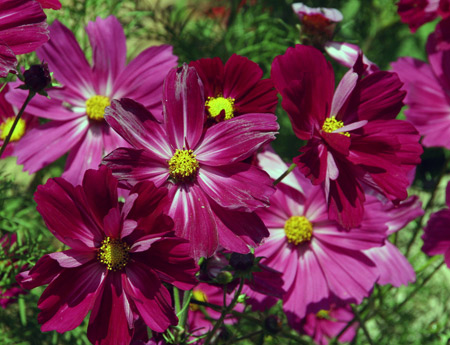

There are few annuals that are easier to work for the home gardener than the cosmos.
Aside from the fact that these plants offer diverse color combinations and adaptability in the garden, they can be started at home by anyone. Children will marvel at the size, shape and quick germination of the seeds and seniors who may have some problems handling smaller objects will find these larger seeds a pleasure to work with.
For the slightly more agile or experienced gardener, a flat of 48 cells can be sown in about two minutes with flowers appearing in as few as eight weeks.
Rich, fertile soil is not one of the requirements for this plant or its seeds. In fact, cosmos prefer a light soil.
If you choose to sow the seed directly into an outdoor bed or cold frame, you simply need to wait until the soil temperature reaches 65 degrees. Just wait until mid to late May.
Seeds will germinate in five to six days. For those of you who winter in warmer climes, seed can be sown in September and these plants will flower all winter.
For those of us who start our seeds under artificial lights or on windowsills, the seed can be sown as early as the first week in March. No problem that we’re already late because later sowings result in later flowers that last longer into the summer.
The simplest way to get cosmos going is to use what we call a standard 1020 flat with a 1204 insert. The 1020 flat is the industry standard plastic flat, which is about 11 inches wide and 22 inches long and has small drainage slits in the bottom. A sheet of plastic cells, called an insert, slips into the flat and then can be filled with germinating soil. The best size insert to use is a 1204, which contains 12 sets of four cells per sheet, resulting in 48 cells.
Both the flats and inserts are available at garden centers and can be reused dozens of times.
Some stores sell clear plastic domes that fit over these flats, which allow heat and moisture to be retained and which will speed up germination. But if left in direct sunlight, the dome will spell doom as the seedlings will cook instead of germinating. In addition, if the dome is left on too long, the humid atmosphere will be just perfect for molds and diseases to take hold.
Remember to germinate in bright light, not direct sunlight, and move your seedlings to sunlight only after they are past the two-true-leaf-stage and the flat is domeless. To explain the terminology, the initial leaves that appear when a seed germinates are called cotyledons and are embryonic leaves. The next set of leaves that emerge are the true leaves that initiate photosynthesis. It’s safe to place plants in direct sunlight after these two events, the two-true-leaf-stage has occurred.
A short note of caution: Never use soil from the outdoor garden to germinate your seeds. This goes for all plants, not just cosmos. In most instances, outdoor soil contains fungus that can result in damping off, or seed rot, which will destroy your seedlings. Modern germinating mixes that are mostly sterile greatly reduce this risk.
You can also germinate your seeds in milled sphagnum moss, which comes prepackaged.
First fill the flat (or whatever planting container you choose to use) and lightly tap it to remove any air pockets. If possible, it also helps to lightly, and I do mean lightly, moisten the soil with warm water before it is used.
Next, make a small depression for the seed with your finger or a pencil eraser. This is called dibbling. Your hole should be no deeper than one-quarter of an inch and as long as the seed.
Place one to two seeds in each cell depression and lightly cover them with dry soil so the depression and seed are no longer visible. Some seeds need light to germinate, but this one needs dark, so make sure it’s covered. Finish up by lightly watering (a spray mist is best) the flat so the soil is evenly moist, not wringing wet or saturated, but moist.
Using a pencil and a plastic plant label, write the variety and date on the label and put the label in the flat so you will have a record of what the flat contains and the date it was sown. I always put a label in each end of the flat knowing that one will always get lost.
The pencil and plastic label are important because the pencil markings will not fade in the sun or wash off like ink markings. Pencil markings on plastic garden tags will last for years even in direct sun.
Your flat is now ready to be covered with a dome or plastic wrap and a soil temperature of 70 degrees should be maintained. This is the ideal temperature, though anything from 68 to 85 degrees will work, with varying results.
Remember to keep the flat moist. When the seeds begin to germinate, remove the dome or cover. Turn the flat every couple of days if the seedlings begin to bend toward the light.
Once the first set of true leaves develops, you can begin to fertilize weekly with a water soluble fertilizer at one-quarter the recommended label rate.
When the plants are about 2 inches high, they are ready for hardening off, either in a cold frame or outdoor location shielded from frost, wind and direct sun. Planting can take place this year any time after Monday, April 20, though waiting a week longer may be advisable, especially for those gardening east of Southampton.
Keep the plants well-watered for a couple of weeks, then you can almost ignore them. Remember that cosmos are drought-tolerant and adapt well if mulched and occasionally deadheaded and fertilized.
Properly started cosmos will never need to be staked. But overfed plants or ones grown in too much shade will be weak and may need to be staked.
Diseases and insects are rarely a problem. Spider mites seem to like this plant, especially when it’s hot and dry, but they can be easily dislodged and discouraged with sprays of water that simply wash them away.
Aphids can also be a nuisance, but these too can be easily controlled with insecticidal soap. At the first sign of aphids, apply the soap (as per the label directions) either in early morning or early evening and let it sit for a half hour, then wash off. You may need to repeat this every few days for a total of three applications.
Once you get the aphids (and mites) under control early in the season, later outbreaks can be easily managed.
Several years ago we did a very late sowing of cosmos in a 6-acre field. The display was just magnificent that fall and the following spring, but then the self reseeding became less reliable and reseeding was necessary the third year.
You might want to try this type of planting on a smaller scale and if it works in your situation, expand. Sow the seeds in early August and you’ll have flowering plants by late September.
Unfortunately, with the first frost, the plants are toast. The good news, though, is that if the plants have set seed before the frost, they will drop to the ground and may germinate the following summer.
Keep growing.
Andrew Messinger has been a professional horticulturist for more than 30 years. He divides his time between homes and gardens in Southampton, Westchester and the Catskills. E-mail him at: Andrew@hamptongardener.com. The Hampton Gardener is a registered trademark.
 More Posts from Andrew Messinger
More Posts from Andrew Messinger